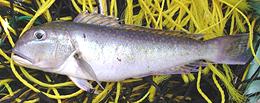 [family Malacanthidae (tilefish)]
[family Malacanthidae (tilefish)]
Tilefish are a worldwide family that eats either plankton or forages
on the bottom for invertebrates. These fish live in burrows of their own
construction.
Mercury: Tilefish are at the top of the FDA's list of
mercury containing fish. This is based on a 1978 study of a few fish from
a single location in the Gulf of Mexico. Tilefish do not at all fit the
profile for high mercury fish. The test results are either an aberration
or simply defective. The FDA's own 2002 figures for Atlantic tilefish show
low mercury - 0.144 ppm, well within safe limits. I suspect the Pacific
tilefish, Ocean Whitefish, would be similar or lower.
More on Varieties of Fish
(very large page).
 [Caulolatilus princeps]
[Caulolatilus princeps]
This East Pacific fish is found from Vancouver Island, Canada to Peru
(though rare north from Central California) and can grow to over 40
inches and over 12 pounds. The photo specimen was 17-1/2 inches and
1-1/4 pounds but I have bought them up to 21 inches and 4-1/2 pounds.
The FDA tilefish mercury warning (see above) does not apply to this
fish, it is safe and an excellent all around eating fish.
Details and Cooking.
 [Golden Tilefish (fishbase); Lopholatilus chamaeleonticeps]
[Golden Tilefish (fishbase); Lopholatilus chamaeleonticeps]
This fish, found in the West Atlantic from Nova Scotia, Canada through
the Gulf of Mexico and Caribbean, and down to northern Brazil, can grow
to over 49 inches and 66 pounds. This fish is on the mercury warning
list based on one set of Gulf of Mexico samples, which are highly
suspect, as tilefish do not fit the high mercury profile. Even the
FDA admits Great Northern Tilefish from the Atlantic are safe, with
a mercury content of 0.144 ppm, well within safe limits. Due to this
listing, Great Northern Tilefish is now sold as "Golden Snapper" or
"Golden Bass". See Ocean Whitefish For
Details and Cooking.
Photo by U.S. Federal Government = Public Domain.
 [Blueline Tilefish; Caulolatilus microps]
[Blueline Tilefish; Caulolatilus microps]
This fish, found in the West Atlantic from North Carolina around Florida
and into the Gulf of Mexico can grow to over 35 inches and 15 pounds.
Smaller and much shorter lived than the Golden Tilefish it seems quite
unlikely it would have a high mercury level.
Drawing by U.S. Federal Government (NOAA) = public
domain.